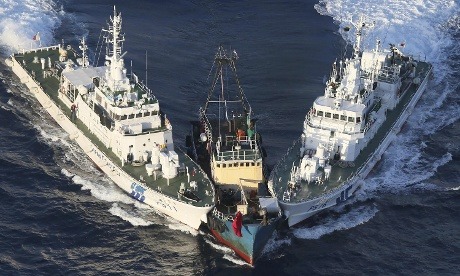The pincer attack on macro models

I don't do much macro-dissing these days, but this Brad DeLong post makes me unable to resist putting in a quick dig.
DeLong quotes Robert Lucas from a 2011 panel on rational expectations:
[Using behavioral economics for macro] is like saying that we ought to build it up from knowledge of molecules or--no, that won’t do either, because there are a lot of subatomic particles.... We’re not going to build up useful economics in the sense of things that help us think about the policy issues that we should be thinking about starting from individuals and, somehow, building it up from there.
DeLong responds:
[When Lucas] builds his models he is aggregating up the behavior of 310 million American individuals, having made certain assumptions about what things cancel out when that aggregation is made...
Lucas does say that economists definitely should not:
- Model humans as they actually behave.
- Model their economic interactions as they actually happen.
- Aggregate up.
- And look for emergent patterns to fit to the data.
Instead Lucas says economists should:
- Do what macroeconomists currently do.
- This is, assume one infinitely-lived hyper-rational representative price-taking agent.
- Assume that all equilibrium-selection and coordination problems are automagically solved.
The second, Lucas says, is "science"! The first, Lucas says, is not--even though the first is a strict superset of the second.
DeLong is exactly right. Also, I like the word "automagically".
Anyway, Lucas' ideas about modeling are pretty typical of modern macro defenders (possibly because he had a big part in inventing those ideas). Modern macro methods commonly face attacks from two other groups of economists:http://newmonetarism.blogspot.com/2015/03/lucas-and-his-critics.html
Attacker Group 1: "Old Keynesian" economists who want to use aggregate-only models.
Attacker Group 2: Decision theorists and other micro theorists who want to make macro use more realistic models of agent behavior.
The modern macro defenders' typical response to Attacker Group 1 is: "No, we need to model agents' decisions, because only then can we be confident that these are structural (and, hence, policy-invariant) models. Simply matching aggregate data is not enough."
The modern macro defenders' typical response to Attacker Group 2 is: "No, we don't need to model agents' decisions realistically, because the only measure of whether a macro model is successful is whether it matches the aggregate data."
This leaves modern macro defenders in the odd position of saying that it's crucially important to model agents' decisions, but totally unimportant to model them in a realistic way.
The natural next question for a macro troll to ask is: "If the agent's behavior isn't being modeled in a realistic way, how can we be confident that the preference parameters are really structural?"
Updates:
As usual, Robert Waldmann beat me to the troll.
Steve Williamson responds. He writes:
[W]hen we say that macroeconomic theory has "microfoundations," what we mean is not that it is built up from theory that explains the behavior of individuals. For a lot of economic behavior, we're not going to do very well in explaining the behavior of an individual. And, as Lucas notes, behavioral economists can't do it either. Rather, what "microfoundations" is about is finding the model elements - optimizing behavior, constraints, information - that explain the behavior of large (that's large in the "larger than one but much smaller than 280 million" sense) groups of economic agents from first principles. Then we can make predictions about the effects of policy on the behavior of really large (i.e. 280 million for example) groups of people.
I guess I don't really get this. So there are some intermediate-sized groups of people - much bigger than 1 but much smaller than 280M - who collectively behave like the "agents" that we see in macro models. But these intermediate-sized groups - let's call them "clumps" - don't behave anything like the individuals that comprise them. But we can still treat the parameters that describe the tastes of the clumps as structural. Why? Because of "first principles." Individuals don't have a disutility of labor parameter, or a coefficient of relative risk aversion. But clumps do. And we know that from first principles.
I must be missing something, because this doesn't sound like anything I've read in a macro paper or book. It also doesn't really make sense, but that's a topic for another day...
Meanwhile, in the comments, Tore Ellingsen asks me what I would work on if I were doing macro theory. A great question. I gave some responses, including extrapolative expectations and firm-side frictions and constraints (e.g. borrowing constraints). I also think there's a lot out there to mine from the I/O and the banking theory literature, but here my knowledge is just way too inadequate to name specifics. In terms of things people are doing now, I like the learning models of Evans, and the dispersed-information models of Angeletos, though I'm not sure if either of those were actually inspired by micro research.
In the comments, Steve Williamson says:
Your rewording of what I was trying to say makes no sense to me. That's not what I'm getting at...So, what are microfoundations? That's not building up a macro model from theory that predicts the behavior of individuals, as we don't have theory that does that. It's taking the best available economy (sic) theory we have - that somehow makes sense of average behavior - and we incorporate that in our macro model.
I'm a little relieved that I got Steve wrong at first, since the "clumps" thing indeed made no sense. But unfortunately, this explanation still doesn't make sense to me. What is "the best available economy theory"? Best by what criterion? And what does it mean to "make sense of average behavior", if not matching macro facts? What else could it mean to "make sense of average behavior"? So I'm still confused.
(Discussion continues in the comments.)